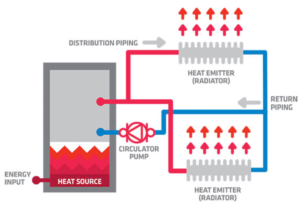What Is Hydronic Heating and Why Do Your Technicians Need to Understand It?
Every HVAC business owner should have at least a cursory understanding of hydronic heating. More importantly, your technicians should have a deeper understanding of it, as they will likely work with hydronic heating systems regularly. If your technicians are not familiar with hydronic heating, your business will miss out on a large segment of customers, as you will be unable to assist them.
As such, it is wise for business owners to at least skim this article to familiarize themselves with hydronic heating to ensure that their technicians know all the ins and outs of it. As the business owner, there are also some aspects of hydronic heating you should be familiar with, such as pricing, efficiency, and the benefits associated with it, as this will help with budgeting and marketing.
What Is Hydronic Heating?

Hydronic heating is also commonly known as radiant heating. It is growing in popularity due to its ability to reduce homeowners’ environmental impact and heating bills while improving their interior comfort.
Hydronic heating systems feature hot water or another liquid. This liquid starts in a boiler that efficiently heats it. From there, liquid moves into the plumbing manifold, which serves as a control center for the system. The system has numerous pumps that continuously work to bring a fresh supply of heated water to the tubing and bring the slightly cooled water back to the boiler to reheat. The system is a closed-loop.
In hydronic systems in homes, there are panel radiators in various rooms, which produces natural radiant heat that can then spread. Homeowners can adjust each of these radiators, letting each room have a different temperature.
In addition to HVAC systems in homes, a radiant or hydronic system can also be used in swimming pools, towel rails, floor slabs, and other areas requiring heat.
Read here for The 25 best HVAC Tools.
How Common Are Hydronic Heating Systems?
A growing number of people are choosing hydronic heating systems, thanks to the numerous benefits this option brings, such as:
- Evenly distributing heat
- No circulation of allergens or dust
- Increased efficiency
- Quiet
- Flexible design
Major Trends Influencing Hydronic Heating – Types of Systems You May See
Radiant heating is available in several different styles.
Baseboard
Baseboard hydronic heating or a hot water baseboard is when the hot water pipe is fitted under the baseboard’s steel housing. Metal fins surround that pipe to spread the heat.
Hydro-air Heating
This type of hydronic heating system involves installing ductwork and air handlers or radiators in each room. This system is incredibly popular because it costs less than hydronic floor heating, and homeowners can use the same ductwork for their air conditioning.
Hydronic Radiant Floor
These systems turn the entire floor into a radiator. The plastic tubing gets installed underneath the floor. There are limited options for flooring for this system, including installation underneath wood or tile or embedded in concrete slabs. Homeowners should not use radiant floors with carpet, as carpet is a poor conductor of heat.
There are also several alternatives to liquid-based hydronic heating used for floors worth mentioning.
- Air-heated Radiant Floors: As the name implies, these hydronic heating floors use heat in the air. These are one of the least common types of radiant heat floors, as they are not very cost-effective due to the inability of air to hold heat well.
- Electronic Radiant Floors: Electronic radiant floors are a variation that includes installing electrical cables underneath the floor instead of using pipes from the hydronic heating system. Because electricity is so expensive, these are not typically very cost-effective.
Importantly, hydronic radiant floors are more efficient than either of these.
The Individual Pieces of Hydronic Heating – Warnings and Installation Safety
Overall, hydronic heating is safe. However, there are a few caveats that HVAC technicians and homeowners should be aware of.
It Is Among the Safest Options
The good news is that hydronic heating is among the safest options for heating a space. Remember that it does not circulate allergens or dust, which could aggravate allergies or cause other issues.
Additionally, the system is completely enclosed, and the radiator keeps the temperatures under the boiling point, dramatically reducing the risk of burns.
Hot Surfaces
One of the few concerns with hydronic heating safety is that the radiator can get very hot to the touch. As such, homeowners with small children need to be careful. There are alternatives to this, such as natural convectors that do not get as hot on the exterior.
Winter Concerns
It is important to note that if there is no power running to the hydronic heating system and cold outside, such as during a winter power outage, the liquid in the pipes and boiler can freeze. This freezing could lead to burst pipes.
There are some alternatives, including some systems that do not require external power. This leaves it with just the convection, which is enough to stop the pipes from freezing but not enough for the system to keep the building warm.
How Does Hydronic Heating Compare to Other Systems? Common Questions and Answers from Customers.
As mentioned, hydronic heating tends to be more energy-efficient than other heating systems. Plus, it does not circulate allergens in the air, unlike comparable systems.
These are common questions your customers are asking. Help educate your technicians on the proper ways to answer them to improve customer satisfaction and retention.
1. Is Hydronic Heating Cheap to Run?
Yes, hydronic heating is typically cheaper to run than other heating systems, thanks to its improved efficiency. Some estimates indicate that it will just cost $1 to $5 to run the system for a full day.
2. How Much Is a Hydronic Heating System?
The hydronic heating system typically costs between $2,539 and $3,060. This figure does not include labor or the other supplies technicians need to install the system. It typically takes about 12 hours to install the system, which will cost $695 to $875. The additional supplies and materials typically cost $233 to $270. This results in a total cost to the homeowner of $3,468 to $4,204 per room.
The price will vary based on numerous factors, including the size of the space, the type of system chosen, and your location.
3. Is Hydronic Heating Energy-efficient?
Of the various heating systems, hydronic heating is among the most efficient. This is due to multiple factors, including its ability to distribute heat evenly. This contrasts with units that force air to heat the space, as the warm air goes to the ceiling. Since the air distributes evenly, you will not lose excess heat to the roof and be forced to increase the temperature. The fact that warm air heated by hydronic heating does not go up to the ceiling makes it particularly efficient for spaces with high ceilings.
Another reason for the efficiency of hydronic heating is that water conducts heat better than air. This makes it easier to move heat between rooms.
4. Can Hydronic Heating Be Used to Cool?
While most people think of hydronic heating as only producing heat, the system can also be used for cooling. This comes from the fact that water conducts cooling, just like it conducts heating. To use hydronic heating for cooling, you would set the water temperature slightly below the ideal indoor temperature.
Conclusion: The Importance of Hydronic Heating and Communication With Technicians
Given the popularity of hydronic heating, it is crucial that your technicians understand these systems. This will ensure that you can assist all of your customers and improve the technicians’ efficiency during installation. As a business owner, you should let your technicians know the importance of hydronic heating and ensure they understand all the concepts covered here.
Ensuring that your technicians understand hydronic heating is far from the only type of communication you will need to have with your technicians. Podium Teamchat can help you ensure you are always on the same page. You can even try the Podium for free, including Inbox and Webchat, to help you communicate with your customers and technicians.



